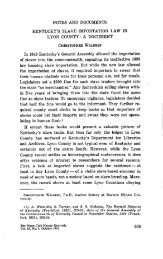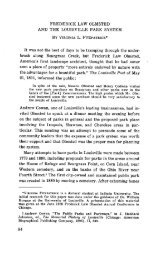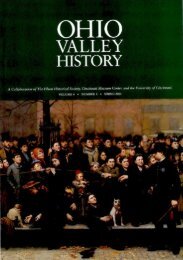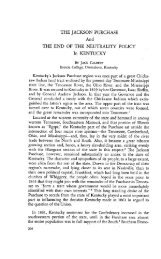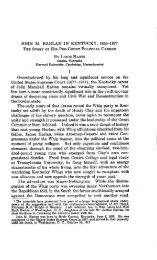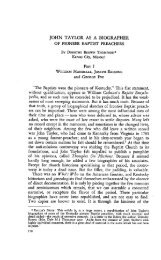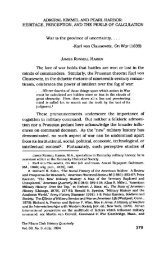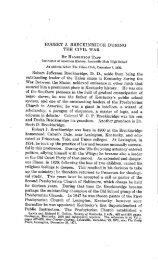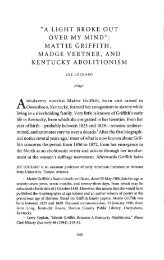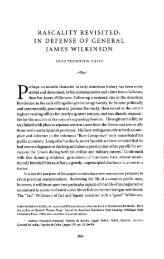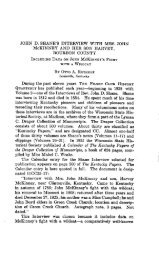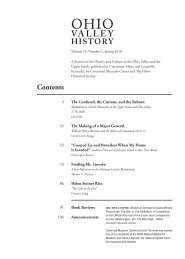Himlerville: Hungarian Cooperative Mining in Kentucky - The Filson ...
Himlerville: Hungarian Cooperative Mining in Kentucky - The Filson ...
Himlerville: Hungarian Cooperative Mining in Kentucky - The Filson ...
You also want an ePaper? Increase the reach of your titles
YUMPU automatically turns print PDFs into web optimized ePapers that Google loves.
THE FILSON CLUB<br />
HISTORY QUARTERLY<br />
VOL. 66 OCTOBER 1992 NO. 4<br />
HIMLERVILLE :<br />
HUNGARIAN COOPERATIVE MINING IN KENTUCKY<br />
DOUG CANTRELL<br />
Much has been written about American immigration and<br />
Appalachian coal m<strong>in</strong><strong>in</strong>g. With the exception of a few articles<br />
by Magaret Ripley Wolfe, Constant<strong>in</strong>e Bellissary, and Rose<br />
Fields, however, scholars have yet to l<strong>in</strong>k the two topics.I Yet<br />
despite the oversight, immigration was an important part of the<br />
Appalachian coal <strong>in</strong>dustry. Coal m<strong>in</strong><strong>in</strong>g <strong>in</strong> southern Appalachia<br />
developed about the same time as millions of southern and eastern<br />
European immigrants entered the United States <strong>in</strong> search<br />
of <strong>in</strong>dustrial employment. Between 1880 and 1930 thousands of<br />
new immigrants settled <strong>in</strong> the coalfields of Alabama, Virg<strong>in</strong>ia,<br />
DOUG CANTRELL, M.A., teaches history at the Elizabethlown Community<br />
College.<br />
1 <strong>The</strong> follow<strong>in</strong>g articles by Margaret Ripley Wolfe, "Aliens <strong>in</strong> Southern Appalachia,<br />
1900-1920: <strong>The</strong> Italian Experience <strong>in</strong> Wise County, Virg<strong>in</strong>ia," Virg<strong>in</strong>ia<br />
Magaz<strong>in</strong>e of History and Biography 87 (1979): 455-72; "Aliens <strong>in</strong> Appalachia:<br />
<strong>The</strong> Construction of the Cllnchfield Railroad and the Italian Experience," <strong>in</strong><br />
Emmet M. Ess<strong>in</strong>, 111 ed., Appalachia: Family Traditions <strong>in</strong> Transition (Johnson<br />
City, Tenn.: East Tennessee State University Press, 1975); "Aliens <strong>in</strong> Southern<br />
Appalachia: Catholics <strong>in</strong> Coal Camps," Appalachian Heritage6 (1978): 42-56:<br />
and "Putt<strong>in</strong>g <strong>The</strong>m <strong>in</strong> <strong>The</strong>ir Places: Industrial Hous<strong>in</strong>g <strong>in</strong> Southern Appalachia,<br />
1900-1930," Appalachian Heritage 7 (1979): 27-36, discuss, to a limited degree,<br />
the new immigration <strong>in</strong> the southern coalfields. A recent article on the subject<br />
is Doug Cantrell, "Immigrants and Community <strong>in</strong> Harlan County, 1910-1930,"<br />
Register o/ the <strong>Kentucky</strong> Hist6rical Society 86 (1988): 119-41. An article by<br />
Constant<strong>in</strong>e G, Belissary, "Tennessee and Immigration, 1865-1880/' Tennessee<br />
Historical Quarterly 7 (1948): 229-48, relates the efforts of Tennessee to attract<br />
immigrants. An early article on the subject is by Rose C. Fields, "What 1 Found<br />
<strong>in</strong> Lynch, <strong>Kentucky</strong>," Success, March 1926, pp. 58-61, 114-19. Brief passages<br />
deal<strong>in</strong>g with new immigrants <strong>in</strong> Appalachia are found <strong>in</strong> Ronald D. Eller, M<strong>in</strong>ers,<br />
Millhands, and Mounta<strong>in</strong>eers (Knoxville, Tennessee: University of Tennessee<br />
Press, 1983) and Harry.M. Caudill, Night Comes to the Cumberlands (Boston:<br />
Little, Brown & Company, 1963). In general, literature on the new immigration<br />
<strong>in</strong>to the southern coalfields is limited.<br />
<strong>The</strong> <strong>Filson</strong> Club History Quarterly<br />
Vol. 66, No. 4, October 1992 513
514 <strong>The</strong> <strong>Filson</strong> Club History Quarterly [October<br />
West Virg<strong>in</strong>ia, <strong>Kentucky</strong>, and Tennessee. Accord<strong>in</strong>g to a fortytwo-volume<br />
report of the United States Immigration Commission,<br />
immigrant workers made up thirty percent of all m<strong>in</strong>e workers<br />
<strong>in</strong> these states <strong>in</strong> 1908.2 <strong>Hungarian</strong>s constituted one of the largest<br />
of the ethnic groups. <strong>Hungarian</strong>s were found <strong>in</strong> virtually all<br />
southern coal-produc<strong>in</strong>g regions. <strong>The</strong>y were so numerous, <strong>in</strong><br />
fact, that they established a cooperative m<strong>in</strong><strong>in</strong>g town <strong>in</strong> the hills<br />
of Mart<strong>in</strong> County. This town, named <strong>Himlerville</strong> after Mart<strong>in</strong><br />
Himler, the group's leader, was America's only experiment with<br />
cooperative coal m<strong>in</strong><strong>in</strong>g.<br />
Mart<strong>in</strong> County, chosen by President Lyndon B. Johnson to<br />
launch his war on poverty, had not always been one of the<br />
poorest counties <strong>in</strong> America. In the 1920s thick seams of coal<br />
were m<strong>in</strong>ed daily, and Mart<strong>in</strong> County was one of the most<br />
prosperous and progressive areas <strong>in</strong> America. In 1925 the<br />
county's m<strong>in</strong>es produced 438,076 tons of coal) At that time,<br />
Mart<strong>in</strong> County boasted of a prosperous bank, two widely read<br />
newspapers, and a variety of enterprises geared to support the<br />
m<strong>in</strong><strong>in</strong>g <strong>in</strong>dustry. This burst of economic activity dur<strong>in</strong>g the era<br />
of Prohibition centered around <strong>Himlerville</strong>, a coal-m<strong>in</strong><strong>in</strong>g town<br />
on Buck's Creek, a tributary of the Tug Fork of the Big Sandy<br />
River) Today hardly anybody remembers this m<strong>in</strong><strong>in</strong>g community<br />
which nestled <strong>in</strong> the hills of eastern <strong>Kentucky</strong> from 1919<br />
until 1928. Even though it has been largely forgotten, Himler-<br />
2 U.S. Senate, Reports ol the Immigration Commission, Immigrants <strong>in</strong> Industry,<br />
<strong>The</strong> Bitum<strong>in</strong>ous Coal Industry, Doc. No. 533, Wash<strong>in</strong>gton, D.C.: Government<br />
Pr<strong>in</strong>t<strong>in</strong>g Office, 1911, 3, pt. I: 139 (hereafter Immigration Commission). Other<br />
sources which discuss immigration and American <strong>in</strong>dustry <strong>in</strong>clude: John Bodnar,<br />
Immigration and Industrialization (Pittsburgh: University of Pittsburgh Press,<br />
1977); David Ward, Cities and Immigrants (New York: Oxford University<br />
Press, 1965); Daniel Nelson, Managers and Workers: Orig<strong>in</strong>s o] the New Factory<br />
System <strong>in</strong> the United States, 1880-1920 (Madison, Wiacons<strong>in</strong>: University of Wiscons<strong>in</strong><br />
Press, 1975). Immigrant communal <strong>in</strong>stitutions are discussed <strong>in</strong> Humbert<br />
S. Nelli, Italians <strong>in</strong> Chicago (New York: Oxford University Press, 1970), From<br />
Immigrants to Ethnics (New York: Oxford University Press, 1983); se¢ also<br />
Thomas Kessner, <strong>The</strong> Golden Door: Italian and ]ewish Immigrant Mobility <strong>in</strong><br />
New York City, 1880-1915 (New York: Oxford University Press, 1977).<br />
3<strong>Kentucky</strong>, Department of M<strong>in</strong>es, Annual Report, 1925 (Frankfort: State<br />
Journal pr<strong>in</strong>t<strong>in</strong>g Company), 82.<br />
4 Ibid., 1923, p. 267.
1992] HimlerviUe 515<br />
v<strong>in</strong>e rema<strong>in</strong>s a unique Appalachian coal-m<strong>in</strong><strong>in</strong>g town. <strong>The</strong> town<br />
was unique because it was based on an experiment with cooper-<br />
ative capitalism by a group of <strong>Hungarian</strong> immigrants,s<br />
<strong>The</strong> idea for a cooperative m<strong>in</strong><strong>in</strong>g enterprise <strong>in</strong> southern Ap-<br />
palachia was conceived by Mart<strong>in</strong> Himler, a <strong>Hungarian</strong> immi-<br />
grant, journalist, and philanthropist, .who was owner, editor,<br />
and publisher of Magyar Banyaszlap (translated as the Hun-<br />
garian M<strong>in</strong>ers' Journal), a foreign-language newspaper which<br />
began publication <strong>in</strong> New York <strong>in</strong> 1916. Himler, a <strong>Hungarian</strong><br />
Jew who was born at Prazsto, Hungary, on 2 September 1888,<br />
emigrated to the United States <strong>in</strong> 1907. Himler successfully<br />
adjusted to a new life <strong>in</strong> America after he found employment <strong>in</strong><br />
a coal m<strong>in</strong>e at Thacker, West Virg<strong>in</strong>ia. He worked several years<br />
at various m<strong>in</strong>es <strong>in</strong> Ohio, Pennsylvania, and West Virg<strong>in</strong>ia be-<br />
fore return<strong>in</strong>g to New York where he was employed as a clerk<br />
<strong>in</strong> a <strong>Hungarian</strong>-American import company. In 1916 he quit<br />
clerk<strong>in</strong>g and went <strong>in</strong>to bus<strong>in</strong>ess for himself. S<strong>in</strong>ce he was edu-<br />
cated as a journalist, he decided to beg<strong>in</strong> publication of a Hun-<br />
garian-language newspaper. With little f<strong>in</strong>anc<strong>in</strong>g he founded<br />
Magyar Banyaszlap on New York's lower east side. Because he<br />
had worked <strong>in</strong> coal m<strong>in</strong>es, Himler's newspaper focused on the<br />
m<strong>in</strong><strong>in</strong>g <strong>in</strong>dustry. When he named his paper the M<strong>in</strong>ers' Journal,<br />
editors of other <strong>Hungarian</strong>-language publications .scoffed at the '<br />
venture, dubbed Himler a parlor m<strong>in</strong>er, and cynically <strong>in</strong>quired<br />
why common <strong>Hungarian</strong> m<strong>in</strong>ers needed their own <strong>in</strong>dustrial<br />
publication,e <strong>The</strong> skeptics did not realize that with<strong>in</strong> a few years<br />
Magyar Banyaszlap would circulate among "more subscribers<br />
than any other three <strong>Hungarian</strong> papers <strong>in</strong> the United States"<br />
and that it would be received by more than 14,000 homes <strong>in</strong> over<br />
1,100 m<strong>in</strong><strong>in</strong>g communities.7<br />
5 Ibid., 1922, p. 286; Eugene S. Bagger, "Himler of <strong>Himlerville</strong>," <strong>The</strong> Survey,<br />
29 April 1922, p. 146 ma<strong>in</strong>ta<strong>in</strong>s that <strong>Himlerville</strong> was perhaps the only cooperative<br />
coal m<strong>in</strong>e <strong>in</strong> the United States; Eller, M<strong>in</strong>ers, 191; Iudge Watson, "<strong>The</strong><br />
Economic and Cultural Development of Eastern <strong>Kentucky</strong> from 1900 to the<br />
Present" (Ph.D. diss., Indiana University, 1963), 48 also discusses the cooperative<br />
nature of <strong>Himlerville</strong>.<br />
6 Bagger, "Himler," 146-47.<br />
7 <strong>The</strong>se claims were made on the masthead of Magyar Banyaszlap. See any
516 <strong>The</strong> <strong>Filson</strong> Club History Quarterly [October<br />
Because he had worked alongside other <strong>Hungarian</strong> coal m<strong>in</strong>ers<br />
for several years, Himler realized that thousands of his country-<br />
men were employed <strong>in</strong> the <strong>in</strong>dustry. As a former m<strong>in</strong>er Himler<br />
understood the problems <strong>Hungarian</strong> m<strong>in</strong>ers faced and the needs<br />
they had. He realized that they had, <strong>in</strong> the words of Oscar Hand°<br />
l<strong>in</strong>, been "uprooted" <strong>in</strong> com<strong>in</strong>g from Hungary to America and<br />
that they were forced to rel<strong>in</strong>quish an agricultural lifestyle <strong>in</strong><br />
favor of an <strong>in</strong>dustrial one to earn a liv<strong>in</strong>g. 8 Himler also recog-<br />
nized that immigrants were often hapless and destitute. <strong>The</strong><br />
search for economic opportunity and the spirit of <strong>in</strong>dependence<br />
that drove them to America were often ext<strong>in</strong>guished by <strong>in</strong>dus-<br />
trial employment. For months Himler thought about the uprooted<br />
condition of his countrymen as they searched for the American<br />
Dream. Eventually he realized that a solution to the problems of<br />
the uprooted <strong>in</strong>volved comb<strong>in</strong><strong>in</strong>g <strong>Hungarian</strong> culture with ideas<br />
of American <strong>in</strong>dustrialism. As scholars have s<strong>in</strong>ce documented,<br />
Himler knew the importance of immigrant reliance on Old-World<br />
habits, values, and lifestyles to forge a mean<strong>in</strong>gful life <strong>in</strong> Am-<br />
erica. Himler's vision of <strong>Himlerville</strong> was that of a community<br />
that would unite the <strong>Hungarian</strong> peasant's landown<strong>in</strong>g, home-<br />
mak<strong>in</strong>g agricultural <strong>in</strong>st<strong>in</strong>cts with American ideals of <strong>in</strong>dustri-<br />
alism. Although the <strong>Hungarian</strong>s would work <strong>in</strong> <strong>in</strong>dustry (a coal<br />
m<strong>in</strong>e), this work would take place <strong>in</strong> a rural sett<strong>in</strong>g (the hills<br />
of eastern <strong>Kentucky</strong>), on land the immigrants owned. While<br />
coal m<strong>in</strong><strong>in</strong>g was dirty and tir<strong>in</strong>g work, it kept the immigrant<br />
<strong>in</strong> touch with the land much as agriculture had <strong>in</strong> the old coun-<br />
try. Unlike factory employment, which alienated immigrants<br />
issue of this largely <strong>Hungarian</strong>-language paper that was pr<strong>in</strong>ted at <strong>Himlerville</strong>,<br />
<strong>Kentucky</strong>, from 1919 until 1928. <strong>The</strong> paper is on microfilm at the Midwest<br />
lnterlibrary Center <strong>in</strong> Chicago, Ill<strong>in</strong>ois.<br />
8Oscar Handl<strong>in</strong>, <strong>The</strong> Uprooted (Boston: Little, Brown & Company, 1954)<br />
proposes the idea that immigrants were uprooted dur<strong>in</strong>g the transition from the<br />
old country to America. Bagger, "Himler," 147 also states that the <strong>Hungarian</strong>s<br />
were "doubly uprooted."<br />
9 Nelli <strong>in</strong> Italians <strong>in</strong> Chicago demonstrates conclusively that immigrants relied<br />
on Old-World customs to adjust 1o life <strong>in</strong> America.
1992] HimlerviUe 517<br />
from the land and their past, coal m<strong>in</strong><strong>in</strong>g kept the connection<br />
between land and immigrant <strong>in</strong>tact.1o<br />
It was 1916 before Himler could beg<strong>in</strong> to establish his rural<br />
<strong>in</strong>dustrial community. With a group of associates he organized<br />
the Himler Coal Company and advertised the formation of a<br />
cooperative m<strong>in</strong><strong>in</strong>g company <strong>in</strong> Magyar Banyaszlap. Stock was<br />
offered for sale only to <strong>Hungarian</strong> natives. <strong>The</strong> idea of a m<strong>in</strong><strong>in</strong>g<br />
corporation where workers would be major stockholders and<br />
where company profits would be paid as dividends to workers<br />
was an entirely new idea with<strong>in</strong> the immigrant community. <strong>The</strong><br />
concept, however, was not without its problems. Sell<strong>in</strong>g stock<br />
through advertisements <strong>in</strong> foreign-language newspapers was a<br />
popular way of sw<strong>in</strong>dl<strong>in</strong>g unsuspect<strong>in</strong>g immigrants out of their<br />
sav<strong>in</strong>gs. Because of the dangers of los<strong>in</strong>g their money, many<br />
immigrants were afraid to <strong>in</strong>vest <strong>in</strong> Himler's scheme. But a large<br />
enough number trusted Himler's reputation for honesty with<strong>in</strong><br />
the immigrant community to enable him to raise $50,000 to<br />
capitalize a m<strong>in</strong><strong>in</strong>g company,n<br />
Aside from its primary purpose of m<strong>in</strong><strong>in</strong>g coal and enabl<strong>in</strong>g<br />
the m<strong>in</strong>ers to experience the <strong>Hungarian</strong> culture <strong>in</strong> an American<br />
environment the company's objectives were to test the theory of<br />
cooperation between labor and capital <strong>in</strong> American <strong>in</strong>dustry and<br />
to Americanize .<strong>Hungarian</strong> immigrants. In order to be consistent<br />
with these goals no one owned a majority of the company's<br />
stock; all m<strong>in</strong>ers work<strong>in</strong>g at <strong>Himlerville</strong> owned stock <strong>in</strong> the<br />
company. Mart<strong>in</strong> Himler, company president, owned less than<br />
three percent of the corporation's outstand<strong>in</strong>g stock. 12 <strong>The</strong> rest<br />
was owned by 1,500 shareholders, many of whom were m<strong>in</strong>ers<br />
employed at <strong>Himlerville</strong>. Those hold<strong>in</strong>g stock who were not<br />
employed at <strong>Himlerville</strong> were generally on wait<strong>in</strong>g lists hop<strong>in</strong>g<br />
10 Eller writes that, "<strong>M<strong>in</strong><strong>in</strong>g</strong>, unlike factory employment, cont<strong>in</strong>ued to provide<br />
contact with the land" (M<strong>in</strong>ers, 175).<br />
11 James R. Haworth. "Hunt<strong>in</strong>gtonians to Take Charge of Development,"<br />
Hunt<strong>in</strong>gton-Herald Dispatch, 22 May 1921; Bagger, "Himler," 147.<br />
12 Mary Lucille Chapman. "<strong>The</strong> Influence of Coal <strong>in</strong> the Big Sandy Valley"<br />
(Ph.D. diss., University of <strong>Kentucky</strong>, 1945), 233; Bagger, "Himler," 146; Eller,<br />
M<strong>in</strong>ers, 191.
518 <strong>The</strong> <strong>Filson</strong> Club History Quarterly [October<br />
that jobs would soon become available. Many stockholders re-<br />
ma<strong>in</strong>ed <strong>in</strong> Hungary, wait<strong>in</strong>g until the m<strong>in</strong>es were developed to<br />
capacity and houses could be built to accomodate them.Is As of<br />
July 1921 the Himler Coal Company's 5,000 shares of common<br />
stock, priced at one hundred dollars each, were held by m<strong>in</strong>ers<br />
<strong>in</strong> such small allotments that it took 450 holders of the largest<br />
lots to form a fifty-one percent majority. 14 By 1923 the com-<br />
pany's stock had risen to 130 dollars per share. Steve Balazs,<br />
a former resident of <strong>Himlerville</strong>, recalled that "that was about<br />
the time I bought 20 to 21 [shares], and it was about 130 to<br />
140 dollars a share....-15<br />
Virtually all <strong>in</strong>habitants of <strong>Himlerville</strong> were <strong>Hungarian</strong>s who<br />
had recently emigrated to the United States. <strong>The</strong> only exceptions<br />
were m<strong>in</strong>e super<strong>in</strong>tendents, foremen, and bank cashiers em-<br />
ployed from time to time. J. D. McLaughl<strong>in</strong>, C. A. Peoke, L. A.<br />
Bowes, A. L. Toshie, E. M. Brown, John F. Ballough, and J. A.<br />
Schuster served at various times as m<strong>in</strong>e super<strong>in</strong>tendents and<br />
foremen,le <strong>The</strong>se Americans worked for salaries because they<br />
were prohibited by the company's bylaws from own<strong>in</strong>g stock.<br />
Only <strong>Hungarian</strong> immigrants were allowed to buy stock <strong>in</strong> the<br />
Himler Coal Company. Every <strong>Hungarian</strong> m<strong>in</strong>er was required to<br />
file naturalization papers if he had not already done so or if he<br />
was not already an American citizen. Only permanent settlers<br />
were encouraged to come to <strong>Himlerville</strong>, and t hey were explicitly<br />
told that their lot <strong>in</strong> life could be improved only through hard<br />
work and perseverance. <strong>The</strong>se immigrants had no delusions of<br />
gett<strong>in</strong>g rich quick. A former resident recalls that the <strong>Hungarian</strong>s<br />
<strong>in</strong> <strong>Himlerville</strong> were a close-knit group who "try to figure out<br />
what they're go<strong>in</strong>g <strong>in</strong>to and if it don't work out.... it stops<br />
13 <strong>Kentucky</strong>, Department of M<strong>in</strong>es, Annual Report, 1922, p. 286.<br />
14 Chapman, "Influence of Coal," 233; Bagger, "Himler," 146.<br />
15Steve Balaza* <strong>in</strong>terview, 20 July 1978, by Floyd Parrish for the <strong>Kentucky</strong><br />
Oral History Commission. Transcript <strong>in</strong> possession of the author.<br />
16 <strong>Kentucky</strong>, Department of M<strong>in</strong>es, Annual Report, 1926, p. 53; 1922, p. 286;<br />
1923. p. 267; 1921, p. 52; 1920, p. 201; 1925, p. 51.
1992] HimlerviUe 519<br />
right there. <strong>The</strong>re's no moan<strong>in</strong>g and argu<strong>in</strong>g about it, if you<br />
made a mistake that's the end of it. ''17<br />
<strong>The</strong> company was governed by an eleven-member board of<br />
directors elected at an annual convention. Except for Himler,<br />
who was chairman of the board, general manager, v.nd m<strong>in</strong>e<br />
super<strong>in</strong>tendent, and Eugene Lang, a young <strong>Hungarian</strong> bus<strong>in</strong>essman<br />
work<strong>in</strong>g on salary as secretary-treasurer, the directors were<br />
all common m<strong>in</strong>ers. Company profits were divided three ways:<br />
one third was paid as a wage/bonus to the stockholders employed<br />
at <strong>Himlerville</strong>; the second third was paid as dividend on the<br />
5,000 shares of stock; and the f<strong>in</strong>al third was added to the<br />
corporation's reserve capital. 18<br />
Actual m<strong>in</strong><strong>in</strong>g operations began <strong>in</strong> 1916 when the Himler Coal<br />
Company purchased a small m<strong>in</strong>e at Ajax, West Virg<strong>in</strong>ia, with<br />
funds from the orig<strong>in</strong>al stock issue. Although this m<strong>in</strong>e had a<br />
tipple from which to transport its coal to market on the Twelve<br />
Pole branch of the Norfork and Western Railroad, the property<br />
was not large enough for a m<strong>in</strong><strong>in</strong>g operation on the scale envisioned<br />
by Himler. So the <strong>Hungarian</strong>s sold the Ajax property<br />
for $150,000 and, after <strong>in</strong>creas<strong>in</strong>g the company's capital stock<br />
to $500,000 with the sale of a second issue of stock, moved across<br />
Tug River to Mart<strong>in</strong> County, <strong>Kentucky</strong>. 19 Here the Himler Coal<br />
Company leased 3,000 acres of prime coal land on the <strong>Kentucky</strong><br />
side of Tug River near Warfield, directly opposite the presentday<br />
town of Kermit, West Virg<strong>in</strong>ia.2°<br />
In 1917 Mart<strong>in</strong> County was largely a wilderness area. Although<br />
huge tracts of unm<strong>in</strong>ed coal lay beneath the hills, there<br />
were no roads to transport it out of the county. <strong>The</strong> nearest railroad<br />
was the Norfork and Western at Kermit, two miles from<br />
<strong>Himlerville</strong>. Between Kermit and <strong>Himlerville</strong> travel was almost<br />
impossible. <strong>The</strong>re was no bridge across Tug River and roads<br />
17 Balazs <strong>in</strong>terview.<br />
18 Chapman, "Influence of Coal," 233-34; Bagger, "Himler," 149.<br />
19 "Tug River Bridge at Warfield, Ky.," Big Sandy News, 27 May 1921.<br />
20<strong>Kentucky</strong>, Department of M<strong>in</strong>es, Annual Report, 1920, I . 201; 1922, p.<br />
286.
520 <strong>The</strong> <strong>Filson</strong> Club History Quarterly [October<br />
were nearly impassable because of mud and deep ruts. Add<strong>in</strong>g<br />
to the transportation problems was Mart<strong>in</strong> County's hilly terra<strong>in</strong><br />
which made travel difficult <strong>in</strong> the best weather. <strong>M<strong>in</strong><strong>in</strong>g</strong><br />
equipment weigh<strong>in</strong>g between ten and twenty tons had to be<br />
floated across Tug River and then dragged the rest of the way<br />
by horses through the mud. Thousands of tons of concrete and<br />
brick had to be transported to <strong>Himlerville</strong> <strong>in</strong> this way. When the<br />
snows melted <strong>in</strong> early spr<strong>in</strong>g, conditions were so bad that it<br />
took six weeks to transport an extremely heavy piece of equipment<br />
from Kermit to <strong>Himlerville</strong>. 21 Several pieces of m<strong>in</strong><strong>in</strong>g<br />
equipment had not been delivered when the <strong>Himlerville</strong> works<br />
were first <strong>in</strong>spected on 9 November 1920 by <strong>in</strong>vestigators from<br />
the <strong>Kentucky</strong> Department of M<strong>in</strong>es and M<strong>in</strong>erals. Yet the im:<br />
migrants would eventually complete this enormous task of build<strong>in</strong>g<br />
a coal town.<br />
<strong>The</strong> <strong>Hungarian</strong>s quickly realized that their major problem<br />
was transportation and that their <strong>in</strong>vestment would be worth-<br />
less unless Mart<strong>in</strong> County was connected to Kermit. To accomplish<br />
this, Himler organized• the Kermit-Warfield Bridge Com-<br />
pany <strong>in</strong> 1919 to construct a steel and concrete bridge across Tug<br />
River between Kermit and Warfield, a small community near<br />
<strong>Himlerville</strong> on the banks of Tug River. <strong>The</strong> bridge company was<br />
capitalized at $125,000, and all its shareholders were m<strong>in</strong>e operators<br />
who owned coal and timber lands on either the <strong>Kentucky</strong><br />
or West Virg<strong>in</strong>ia side of Tug River. Officers of the company<br />
were Daniel Elmer Hewitt, a Hunt<strong>in</strong>gton, West Virg<strong>in</strong>ia, lumber<br />
and coal baron, president; Mart<strong>in</strong> Himler, vice president;<br />
Eugene Lang, treasurer; and M. W. Hale, secretary.<br />
Work on the bridge, which was expected to take ten months<br />
to complete, began <strong>in</strong> July 1919. By November the eng<strong>in</strong>eers had<br />
discovered a bed of quicksand eighteen feet below the riverbed.<br />
Only by drill<strong>in</strong>g to a depth of thirty to forty feet could they<br />
21 Bagger, "Himler," 148; Chapman, "Influence of Coal," 227-29.<br />
22 <strong>Kentucky</strong>, Department of M<strong>in</strong>es, Annual Report, 1920, p. 201.<br />
23 "Tug River Bridge at Warfield, Ky."
1992] HimlerviUe 521<br />
Chuck Perry, Lex<strong>in</strong>gton<br />
Bridge Over Tug River<br />
place the bridge's foundation <strong>in</strong> solid rock. Estimated costs to<br />
complete the work rose to $200,000, but the foal operators wh0<br />
had purchased the orig<strong>in</strong>al stock refused to <strong>in</strong>crease their sub-<br />
seriptions. Himler was forced to borrow $125,000 on twelve-<br />
month bonds morffgaged on the bridge u<br />
Other difficulties ensued, and it soon became apparent that<br />
an additional $100,000 was needed; aga<strong>in</strong> the coal operators de-<br />
manded that Himler advance the money. Himler refused unless<br />
the <strong>Hungarian</strong> cooperative was given complete control over the<br />
bridge. <strong>The</strong> coal operators still refused to <strong>in</strong>vest any more money<br />
<strong>in</strong> the project and opposed giv<strong>in</strong>g the immigrants control of the<br />
bridge because they realized that whoever controlled the bridge<br />
controlled 40,000 acres of Mart<strong>in</strong> County coal and timber re-<br />
sources. Himler stood his ground, and work on the bridge stopped<br />
until the operators met,the immigrants' demands. Himler then<br />
bought out their <strong>in</strong>terests and resumed construction on the<br />
24 Haworth, "Hunt<strong>in</strong>gtonians." 1; ' rug River Bridge at Warfield, Ky.; Bagger,<br />
"Himler," 148.
!4'[1 : j H,;m ,',, : c !%! 52:1<br />
)i',"/rto( (;'>w Tr,' ; , li! ', t ¸<br />
I:'I:,'U (hU hrid z :'>:, f.u::dd ]ml i]/ s::,iJ,:!, tuck ]E :tLmalid L',:,,:l ]]},' mulu I!:l;Ul]l' ,<br />
i]::; 1] 11 I ]:llI4:lllllI ll:l l/]epi:) e [ ,Ki il] t :b I ]IT Li [I' LII 411:] ] []%11] (1 Ihl/<br />
1,] i:lc:,, Ill i i] ,i>;ll 1<br />
I] FIpiI]i:i:e{t l Ll " ll e]ll:lie,l- ] ,m:ll!rl:,lled the I:aq,il m<br />
i ];1 ILI i I] 1) IllqlI tt!li >:i iif ]i l;Y't II II'lILI]lti illi:/ ill:l(! tJ ll])t ] l! -<br />
522 <strong>The</strong> <strong>Filson</strong> Club History Quarterly [October<br />
bridge. After twenty-two months the bridge was completed at a<br />
cost of $300,000. Because the bridge was constructed of steel<br />
and concrete rather than wood, it was considered the best bridge<br />
built across Tug River. <strong>The</strong> Norfork and Western Railroad laid<br />
tracks across the bridge and on 21 May 1921 the first tra<strong>in</strong><br />
crossed <strong>in</strong>to Mart<strong>in</strong> County. <strong>The</strong> Hunt<strong>in</strong>gton Herald Dispatch<br />
<strong>in</strong> an eight-column, front-page story described the event <strong>in</strong><br />
dramatic fashion: "<strong>The</strong> gates of Mart<strong>in</strong> County, <strong>Kentucky</strong>,<br />
locked for countless ages, were thrown wide today, when a tra<strong>in</strong><br />
of two coaches, gaily bedecked and crowded with men, women<br />
and children <strong>in</strong> holiday dress entered.''2e This special tra<strong>in</strong>,<br />
which had Hewitt as the eng<strong>in</strong>eer and Himler as the fireman,<br />
made history for eastern <strong>Kentucky</strong>. It was the first standard-<br />
gauge tra<strong>in</strong> to travel on Mart<strong>in</strong> County soil.<br />
<strong>The</strong> arrival of the Norfork and Western special touched off a<br />
celebration the likes of which Mart<strong>in</strong> County residents had never<br />
seen. When the tra<strong>in</strong> left Kermit a large crowd gathered on<br />
nearby hills to cheer its departure. Himler poured on the coal<br />
and Hewitt opened the throttle, and the tra<strong>in</strong> sped toward Ken-<br />
tucky. As it neared the new bridge the crowd cheered madly,<br />
anticipat<strong>in</strong>g the railroad's first venture <strong>in</strong>to Mart<strong>in</strong> County.<br />
Most realized that the hopes of thousands of Appalachian and<br />
<strong>Hungarian</strong> coal m<strong>in</strong>ers depended on this bridge. So far as resi-<br />
dents of <strong>Himlerville</strong> were concerned, this bridge was the only<br />
one <strong>in</strong> the world. After cross<strong>in</strong>g it the tra<strong>in</strong> entered Warfield<br />
but did not stop to take on the big crowd that had gathered to<br />
board it before go<strong>in</strong>g on to <strong>Himlerville</strong>. Upon enter<strong>in</strong>g Himler-<br />
ville the tra<strong>in</strong>, its whistle shriek<strong>in</strong>g, was met by a blast from a<br />
siren on the powerhouse at the Himler m<strong>in</strong>e. <strong>The</strong> big moment<br />
had arrived amid cheers and happy smiles. <strong>The</strong> tra<strong>in</strong> halted,<br />
its passengers disembarked, and Frank Demjen, a <strong>Hungarian</strong><br />
25 Ibid.<br />
26 Ibid.<br />
27 Haworth, "Hunt<strong>in</strong>stonians," I.
1992] HimlerviUe 523<br />
immigrant, serenaded them with a rendition of "My Old <strong>Kentucky</strong><br />
Home" on his cornet.2a<br />
Portions of the crowd then took a guided tour <strong>in</strong>to the m<strong>in</strong>e<br />
shafts. Follow<strong>in</strong>g the visit to the m<strong>in</strong>e, the crowd assembled <strong>in</strong><br />
front of the powerhouse for speeches from dignitaries gathered<br />
for the occasion. Judge Henry Stephen Howes of Johnson County<br />
delivered the ma<strong>in</strong> speech. He was jo<strong>in</strong>ed by other dignitaries<br />
such as Carl Berger who represented the Berger estate of C<strong>in</strong>c<strong>in</strong>nati<br />
which had leased land to the immigrants. Judge Howes<br />
praised the courage and foresight of both Hewitt and Himler.<br />
His words held hope for the future. Himler then pledged that<br />
although the <strong>Hungarian</strong> cooperative controlled the bridge, it<br />
would not be used for selfish purposes. Instead, Himler promised<br />
that the bridge would be used to develop the economy of Mart<strong>in</strong><br />
County. <strong>The</strong> celebration ended when Eugene Lang distributed<br />
$1,000 <strong>in</strong>surance policies purchased by the Himler Coal Company<br />
to its employees. 29<br />
Shortly after the bridge was completed, the Himler Coal Com-<br />
pany leased an additional 7,000 acres of land conta<strong>in</strong><strong>in</strong>g the Warfield<br />
Seam from the Berger estate and 5,000 acres from smaller<br />
landowners. When added to the company's orig<strong>in</strong>al hold<strong>in</strong>gs,<br />
the leased land gave the <strong>Hungarian</strong> cooperative control of 15,000<br />
acres of coal property.30<br />
When m<strong>in</strong><strong>in</strong>g operations began <strong>in</strong> 1919 the immigrants found<br />
a seam. of high-quality coal. It was the fabled Warfield Seam<br />
which, accord<strong>in</strong>g to local lore, provided coal for steamships on<br />
their way up the Big Sandy River. <strong>The</strong> seam's average height<br />
at the m<strong>in</strong>e face was five feet, and the rock above it was exceptionally<br />
firm which elim<strong>in</strong>ated the need for expensive timber<strong>in</strong>g.<br />
After m<strong>in</strong><strong>in</strong>g had been underway for several years, however, the<br />
quality of the coal decl<strong>in</strong>ed. In some areas, which m<strong>in</strong>ers called<br />
"tops," the shale above the coal was loose and immigrants could<br />
28 Ibid.<br />
29 Ibid.<br />
30 Ibid.; Bagger, "Himler," 150.
524 <strong>The</strong> <strong>Filson</strong> Club History Quarterly [October<br />
not control it. <strong>The</strong> company was forced to timber these places.<br />
When state <strong>in</strong>spectors visited the m<strong>in</strong>e <strong>in</strong> 1920, they found poor<br />
dra<strong>in</strong>age, poor ventilation, and excessive methane gas) 1 <strong>The</strong><br />
coal also conta<strong>in</strong>ed many impurities, such as sulphur and ash,<br />
that had to be removed. Unfortunately, the immigrants lacked<br />
the knowledge to remove impurities from it. <strong>The</strong> coal from the<br />
<strong>Himlerville</strong> works acquired a bad reputation <strong>in</strong> coal markets<br />
so the <strong>Hungarian</strong> cooperative found it difficult to sell.<br />
<strong>The</strong> estimated cost of build<strong>in</strong>g the plant and town was orig<strong>in</strong>-<br />
ally $250,000. This estimate fell short by $500,000 as total ex-<br />
penditures reached more than $750,000. <strong>The</strong> cost over-run oc-<br />
curred <strong>in</strong> part because equipment used <strong>in</strong> the m<strong>in</strong>e was the best<br />
and most modern available at the time. <strong>The</strong> <strong>Hungarian</strong>s first<br />
<strong>in</strong>vested their sav<strong>in</strong>gs to raise the capital necessary to purchase<br />
m<strong>in</strong><strong>in</strong>g equipment. When the sav<strong>in</strong>gs were exhausted, coopera-<br />
tive members borrowed from American banks.<br />
S<strong>in</strong>ce <strong>Himlerville</strong> was to be a coal-m<strong>in</strong><strong>in</strong>g town the tipple and<br />
powerhouse were built first. <strong>The</strong> tipple, constructed of steel at<br />
a cost of $100,000, was one of the best <strong>in</strong> America. It could pro-<br />
cess 2,500 tons of coal <strong>in</strong> eight hours. In the tipple, coal was<br />
automatically sorted <strong>in</strong>to various sizes by the use of shaker<br />
screens. <strong>The</strong> tipple was constructed so that coal buggies could<br />
be turned 180 degrees to empty their contents without be<strong>in</strong>g<br />
uncoupled from the coal tra<strong>in</strong>. <strong>The</strong> power plant was modern <strong>in</strong><br />
every respect. When an associate suggested that Himler con-<br />
struct a smaller plant at less cost, he responded with character-<br />
istic zeal: '°I am build<strong>in</strong>g not for the present, but for the fu-<br />
ture.''3e He realized that a small plant would become obsolete <strong>in</strong><br />
a few years. Although the company was heavily <strong>in</strong> debt after<br />
f<strong>in</strong>anc<strong>in</strong>g the bridge, Himler went further <strong>in</strong>to debt when<br />
31 <strong>Kentucky</strong>, Department of M<strong>in</strong>es, Annual Report, 1920, p. 201.<br />
32 Balazs <strong>in</strong>terview.<br />
33 "Tug River Bridge at Warfleld, Ky."<br />
34 <strong>Kentucky</strong>, Department of M<strong>in</strong>es, Annual Report, 1920, p. 201; 1922, p. 286.<br />
3S Ibid., 1922, pp. 267-68.<br />
36 Bagger, "Himler," 149.
1992] HimlerviUe 525<br />
$150,000 was raised to build a large power plant. This money<br />
was used to purchase five boilers of two hundred horsepower<br />
capacity to generate electricityto run the m<strong>in</strong>es and light homes<br />
<strong>in</strong> <strong>Himlerville</strong>. Every piece of mach<strong>in</strong>ery <strong>in</strong> the power plant had<br />
a back-up system <strong>in</strong> case of emergency breakdowns)7 <strong>The</strong> construction<br />
of this power plant represented the first commercial<br />
use of electricity <strong>in</strong> Mart<strong>in</strong> County. Wires were strung to most<br />
of the <strong>Hungarian</strong> homes, and if native mounta<strong>in</strong>eers wanted<br />
electricity they could hook on to the Himlerv<strong>in</strong>e l<strong>in</strong>es. While not<br />
all mounta<strong>in</strong> homes were electrically lighted, enough were to<br />
change life on farms <strong>in</strong> the area.<br />
<strong>The</strong> perpendicular m<strong>in</strong>e shaft extended seventy-six feet <strong>in</strong>to<br />
the ground. It was fully l<strong>in</strong>ed with concrete for safety and sloped<br />
at a forty-five-degree angle through solid rock for another sixty<br />
feet before level<strong>in</strong>g off. An elevator, a supply track, and a stairway<br />
ran through the shaft. Before the shaft was completed<br />
10,000 tons of coal were brought to the surface through the<br />
elevator shaft and burned <strong>in</strong> the powerhouse or sold for local<br />
consumption,a At its face, the coal seam averaged from fiftyfour<br />
to sixty-six <strong>in</strong>ches <strong>in</strong> thickness.4° This seam, which geolo-<br />
gists called Number Two Gas or Buck Creek block, was worked<br />
by the slope-m<strong>in</strong><strong>in</strong>g method as the coal lay below the tipple<br />
mouth. Three of the newest models of fifty-horsepower Goodman<br />
shortwall mach<strong>in</strong>es were used to undercut the coal seam. Highpowered<br />
drills were used to bore holes <strong>in</strong> which explosives were<br />
placed to blast the undercut coal loose from the m<strong>in</strong>e face.<br />
M<strong>in</strong>ers then loaded the coal <strong>in</strong>to special buggies which were<br />
conveyed to the tipple by Ironton Storage Battery locomotives.<br />
Workplaces were ventilated by electrically driven fans. <strong>The</strong> m<strong>in</strong>e<br />
was electrically lighted, and all heavy equipment was operated<br />
by electricity.41<br />
37 <strong>Kentucky</strong>, Department of M<strong>in</strong>es, Annual Report, 1922, p. 286.<br />
38 Bagger, "Himler," 150.<br />
39 Ibid.<br />
40<strong>Kentucky</strong>, Department of M<strong>in</strong>es, Annual Report, 1923, p. 305; 1926, p. 53.<br />
41 Ibid., 1920, p. 201; 1922, p. 286; 1923, pp. 267-68.
526 <strong>The</strong> <strong>Filson</strong> Club History Quarterly [October<br />
Although the Himler m<strong>in</strong>e was classified as a mach<strong>in</strong>e m<strong>in</strong>e<br />
by the <strong>Kentucky</strong> Department of M<strong>in</strong>es <strong>in</strong> 1919 and 1920, coal<br />
was shot from the solid and hauled by mules to Warfield where<br />
it was floated across Tug River to Kermit, loaded <strong>in</strong>to railroad<br />
cars, and shipped to northern factories. After the Goodman<br />
shortwall mach<strong>in</strong>es and the Ironton Storage Battery locomotives<br />
arrived <strong>in</strong> 1921, the use of animal labor was discont<strong>in</strong>ued.<br />
Large numbers of men were required to operate the m<strong>in</strong><strong>in</strong>g<br />
mach<strong>in</strong>ery, load coal <strong>in</strong>to the buggies, transport it to the outside,<br />
and work the tipple. In 1921 the Himler Coal Company employed<br />
n<strong>in</strong>ety-five men, twenty-five of which worked outside and seventy<br />
<strong>in</strong>side. That number rose to 226 <strong>in</strong> 1923. Of this number 180<br />
were <strong>in</strong>side workers. After 1923 the number of men employed<br />
fluctuated from 165 <strong>in</strong> 1925 to 207 <strong>in</strong> 1926 and 198 <strong>in</strong> 1927.43<br />
For the m<strong>in</strong>ers who worked <strong>in</strong> <strong>Himlerville</strong>, the work was hard.<br />
<strong>The</strong> <strong>Hungarian</strong> m<strong>in</strong>ers generally worked <strong>in</strong> excess of two hundred<br />
days a year. In 1923 the Himler m<strong>in</strong>e operated 204 days,<br />
<strong>in</strong> 1925 246 days, and <strong>in</strong> 1926 277 days. Workers entered the<br />
m<strong>in</strong>e at 4:00 A.M. to make preparations to load coal. <strong>The</strong> workplace<br />
was first coated with "rock dust" (crushed limestone) to<br />
prevent the coal dust from explod<strong>in</strong>g. <strong>The</strong>n m<strong>in</strong>ers bored several<br />
holes <strong>in</strong> the coal seam for the explosives used to blast the coal<br />
loose. Because the Himler m<strong>in</strong>e was not well ventilated, m<strong>in</strong>ers<br />
had to wait approximately two hours for the smoke to clear<br />
before beg<strong>in</strong>n<strong>in</strong>g to load coal <strong>in</strong>to special buggies until the work-<br />
place was completely cleaned up. When no coal rema<strong>in</strong>ed, the<br />
42Ibid., 1920, p. 201. "Shot from the solid" is a term m<strong>in</strong>ers use to describe<br />
a method of blast<strong>in</strong>g coal from the seam with<strong>in</strong> the m<strong>in</strong>e tunnel. Normally, a<br />
special mach<strong>in</strong>e (called a cutt<strong>in</strong>g mach<strong>in</strong>e or simply the mach<strong>in</strong>e) is used to<br />
undercut a coal seam to make it easier and safer to blast coal from the seam<br />
with explosives. In the early days of m<strong>in</strong><strong>in</strong>g, m<strong>in</strong>ers undercut the coal seam with<br />
picks. If coal is shot from the solid it is blasted from the seam without the<br />
seam hav<strong>in</strong>g been undercut. This is a dangerous method of m<strong>in</strong><strong>in</strong>g and one <strong>in</strong><br />
which m<strong>in</strong>ers are frequently <strong>in</strong>jured or killed. Even today, some small m<strong>in</strong>es,<br />
usually illegal wildcat operations, will shoot coal from the solid because they<br />
cannot afford to buy an expensive cutt<strong>in</strong>g mach<strong>in</strong>e and because it takes too long<br />
to undercut the coal seam with hand picks.<br />
43 Ibid., 1921, p. 52; 1923, p. 305; 1925, p. 167; 1926, p. 177; 1927, p. 162.<br />
44 Ibid., 1923, p. 305; 1925, p. 167; 1926, p. 177.
1992] HimlerviUe 527<br />
workers were free to return home until the next morn<strong>in</strong>g. A<br />
typical workday usually ended around 7:00 P.M. If a m<strong>in</strong>er was<br />
exceptionally fast at load<strong>in</strong>g coal he might be able to leave the<br />
m<strong>in</strong>e several hours earlier. Before leav<strong>in</strong>g, however, they were<br />
required to clean up the workroom. "You cleaned that cut up,"<br />
says one m<strong>in</strong>er, "or you wouldn't have anyth<strong>in</strong>g to do the next<br />
day, you'd have to cut back that night.''4s Most m<strong>in</strong>ers loaded<br />
about six or seven buggies a day. Each buggy held three tons of<br />
coal. When a m<strong>in</strong>er loaded one car he rested until the motorman<br />
(the worker responsible for br<strong>in</strong>g<strong>in</strong>g empty cars <strong>in</strong>to the work-<br />
place and tak<strong>in</strong>g filled ones to the tipple) picked up the filled<br />
cars and left the empty ones.47<br />
Not only was work <strong>in</strong> the Himler m<strong>in</strong>e hard, it was also dan-<br />
gerous. <strong>The</strong>re were numerous ways workers could be killed <strong>in</strong><br />
underground coal m<strong>in</strong>es. <strong>The</strong> Himler m<strong>in</strong>e was not immune from<br />
such disasters. Several fatal accidents occurred <strong>in</strong> the <strong>Himlerville</strong><br />
works. On 15 April 1925 Charles. Soos, a thirty-six-year-old<br />
m<strong>in</strong>er was killed by a slate fall. Two m<strong>in</strong>ers were killed <strong>in</strong> 1926.<br />
On 16 August, Steve Halaiz was electrocuted and on 1 December,<br />
W. M. Patrick was crushed by a roof fall. On 19 September 1927<br />
Joseph Vilieies, a m<strong>in</strong>er with twenty-seven years experience,<br />
was killed by the motor used to haul coal to the m<strong>in</strong>e tipple:4s<br />
Although the work day was long and hard, life was more<br />
pleasant 'bnce m<strong>in</strong>ers returned home. <strong>The</strong> town of Himlervil]e<br />
45 Eller, M<strong>in</strong>ers, 175-82 discusses the m<strong>in</strong>er's work day. Traditionally, m<strong>in</strong>ers<br />
set their own hours at work. A m<strong>in</strong>er blasted coal from the coal seam <strong>in</strong> the<br />
early part of the day. When the m<strong>in</strong>er had loaded all the coal he had blasted<br />
from the coal seam that day <strong>in</strong>to special buggies, he was free to leave the m<strong>in</strong>e<br />
until the next day. However, before leav<strong>in</strong>g the m<strong>in</strong>er had to clean up all the<br />
rock, dirt, and other debris that was shot down alongside the coal. If a m<strong>in</strong>er<br />
did not clean up his workplace before leav<strong>in</strong>g the m<strong>in</strong>e, he hadto waste valuable<br />
time the next morn<strong>in</strong>g clean<strong>in</strong>g up the rock and dirt before he could beg<strong>in</strong> to<br />
m<strong>in</strong>e coal and make money. S<strong>in</strong>ce most m<strong>in</strong>ers were paid accord<strong>in</strong>g to the amount<br />
of coal they dug, it was important to clean up the workplace so that the m<strong>in</strong>er<br />
could immediately beg<strong>in</strong> to dig coal the next morn<strong>in</strong>g.<br />
46 Balazs <strong>in</strong>terview.<br />
47 Eller, M<strong>in</strong>ers, 176-77.<br />
48 <strong>Kentucky</strong>, Department of M<strong>in</strong>es, Annual Report, 1925, pp. 238-39; 1926,<br />
pp. 244-45; 1927, pp. 228-29.
528 <strong>The</strong> <strong>Filson</strong> Club History Quarterly [October<br />
was a planned community. Modeled after Consolidation Coal<br />
Company's town at Jenk<strong>in</strong>s, <strong>Kentucky</strong>, each house conta<strong>in</strong>ed<br />
five rooms, two of which measured fifteen by thirteen feet and<br />
two more fifteen by eleven feet. Each room was plastered and<br />
conta<strong>in</strong>ed two w<strong>in</strong>dows. All houses had a bathroom complete<br />
with tub and shower. Each house, built of fireproof material,<br />
had two open fireplaces for burn<strong>in</strong>g wood or coal and were also<br />
equipped with facilities for gas or electrical heat<strong>in</strong>g. Electricity<br />
was used to light all rooms and each house had a front and rear<br />
porch, a wash house, a vegetable garden, and pens for cows, pigs,<br />
and poultry.49 If they preferred, residents could build houses<br />
accord<strong>in</strong>g to personal taste. As a result of this lenient policy,<br />
homes of the most unusual shape and color perched on the hills<br />
surround<strong>in</strong>g <strong>Himlerville</strong>. A few of the immigrants purchased<br />
exist<strong>in</strong>g log homes from mounta<strong>in</strong>eers <strong>in</strong> the region.5°<br />
<strong>The</strong> ma<strong>in</strong> town consisted of a headquarters build<strong>in</strong>g which<br />
housed the company offices <strong>in</strong> the second story and a feneral<br />
store <strong>in</strong> the first. Like most company stores, the one <strong>in</strong> <strong>Himlerville</strong><br />
sold a variety of merchandise, rang<strong>in</strong>g from cloth<strong>in</strong>g and<br />
tobacco to food and magaz<strong>in</strong>es. <strong>The</strong> store conta<strong>in</strong>ed modern<br />
refrigeration equipment and provided a bathroom for use by<br />
customers. Unlike company stores <strong>in</strong> other coal camps, the one<br />
<strong>in</strong> <strong>Himlerville</strong> did not monopolize retail trade. Other stores were<br />
permitted with<strong>in</strong> the town's limits, and workers were free to<br />
buy from private stores <strong>in</strong> neighbor<strong>in</strong>g communities. Often,<br />
Syrian pack peddlers would come through <strong>Himlerville</strong> sell<strong>in</strong>g<br />
cloth<strong>in</strong>g and cook<strong>in</strong>g utensils. Workers were paid <strong>in</strong> cash every<br />
month; the Himler Coal Company did not issue scrip to keep<br />
employees <strong>in</strong> perpetual debt. Employees were allowed to spend<br />
their wages as they saw fit, except that they were pI:ohibited<br />
from buy<strong>in</strong>g alcoholic beverages.5<br />
For America the 1920s was a time of prohibition. Although<br />
49 Bagger, "Himler," 150; Chapman, "Influence of Coal," 230.<br />
50 Ibid.<br />
51 Ibid.
1992] HimlerviUe 529<br />
the manufacture, sale, and distribution of alcoholic beverages<br />
was forbidden bY the Eighteenth Amendment, illicit trade was<br />
big bus<strong>in</strong>ess. <strong>Kentucky</strong>, from the earliest frontier days, had a<br />
tradition of dr<strong>in</strong>k<strong>in</strong>g. Moonsh<strong>in</strong>e stills were prevalent <strong>in</strong> the hills<br />
and hollows of the state. However, Himler, unlike many Ameri-<br />
cans, took prohibition seriously. He rigorously banned alcohol<br />
from his town. In 1921 he discovered that one of the immigrants,<br />
who operated a board<strong>in</strong>ghouse for men, was sell<strong>in</strong>g moonsh<strong>in</strong>e<br />
whiskey to his boarders. Himler immediately summoned the<br />
immigrant to the company's offices and threatened to turn him<br />
over to revenue agents unless he sold his property and stock <strong>in</strong><br />
the company, renounced all association with <strong>Himlerville</strong>, and<br />
left the community with<strong>in</strong> forty-eight hours. Before the time<br />
had elapsed the man was far from tIimlerville. Himler later<br />
expla<strong>in</strong>ed the offender's absence at a meet<strong>in</strong>g of the company's<br />
board of directors: "I kicked him out. He was sell<strong>in</strong>g liquor to<br />
my m<strong>in</strong>ers.''<br />
Because of Himler's hatred of liquor, <strong>Himlerville</strong> did not have<br />
a big problem with drunkenness. Steve Balazs remembers that:<br />
We never had no too many people that drank, and got drunk, not that<br />
they was a lot of people who drank whiskey, now don't get me wrong,<br />
but they knew when to quit. Ever once <strong>in</strong> a while somebody might have<br />
too many dr<strong>in</strong>ks, didn't want to fight, or do anyth<strong>in</strong>g wrong, they just<br />
got helpless, and was ashamed the next morn<strong>in</strong>g, didn't want anybody<br />
to look at them.53<br />
A bachelor's hotel was erected <strong>in</strong> the center of town..Like the<br />
s<strong>in</strong>gle-family hous<strong>in</strong>g units, the bachelor's hotel was modern <strong>in</strong><br />
all respects, hav<strong>in</strong>g electrical light<strong>in</strong>g, runn<strong>in</strong>g water, and <strong>in</strong>door<br />
bathrooms. This facility was built to counter the moral and<br />
hygenic dangers of the board<strong>in</strong>g-boss system, an <strong>in</strong>stitution that<br />
developed among immigrants <strong>in</strong> other Appalachian coal camps.<br />
52 Bagger, "Himler," 187.<br />
53 Balazs <strong>in</strong>terview.<br />
54 Immigration Commission, 229-32 discusses the board<strong>in</strong>g-boss system as it<br />
appeared among immigrants <strong>in</strong> the Appalachian coalfields; Bagger, "Himler,"<br />
150; Chapman, "Influence of Coal," 231.
530 <strong>The</strong> <strong>Filson</strong> Club History Quarterly [October<br />
Immigrants <strong>in</strong> southern coalfields, as they did <strong>in</strong> northern cities,<br />
tended to congregate under one roof. To save money immigrant<br />
families often kept boarders. It was not unusual for a married<br />
couple to keep from six to ten boarders <strong>in</strong> a small house. <strong>The</strong>se<br />
boarders were usually s<strong>in</strong>gle males of the same nationality as<br />
the board<strong>in</strong>g boss (the name given to the head of the family<br />
keep<strong>in</strong>g boarders) and had usually just arrived <strong>in</strong> the<br />
United States. Beds were placed <strong>in</strong> every room of the house except<br />
the kitchen. Investigators from the United States Immigration<br />
Commission determ<strong>in</strong>ed that such overcrowded liv<strong>in</strong>g<br />
conditions were <strong>in</strong>adequate, unsanitary, and totally deplorable, s5<br />
Himler realized that this practice, more than all others, was<br />
criticized by natives, and he was determ<strong>in</strong>ed to, prevent its establishment<br />
<strong>in</strong> <strong>Himlerville</strong>.<br />
<strong>Himlerville</strong> also conta<strong>in</strong>ed other features that were unique<br />
for an Appalachian m<strong>in</strong><strong>in</strong>g camp. A two-story clubhouse was<br />
built for use by all the town's <strong>in</strong>habitants, and the town bakery<br />
specialized <strong>in</strong> <strong>Hungarian</strong> breads and pastries. <strong>Himlerville</strong> had<br />
its own pr<strong>in</strong>t<strong>in</strong>g press where Magyar Banyaszlap was publishe d<br />
weekly. 56 Advertisements, items of <strong>in</strong>terest from Hungary, local,<br />
state, and national news were pr<strong>in</strong>ted. Accounts of <strong>Himlerville</strong>'s<br />
success were carried to virtually all <strong>Hungarian</strong> communities <strong>in</strong><br />
the United States through the pages of the M<strong>in</strong>ers' Journal. As<br />
a result, many <strong>Hungarian</strong>s wanted to migrate to <strong>Himlerville</strong><br />
where they could live <strong>in</strong> an alien land surrounded by a veneer<br />
of Magyar culture.5T<br />
To meet the recreational and educational needs of <strong>Himlerville</strong>'s<br />
residents, a library was housed <strong>in</strong> the clubhouse. It conta<strong>in</strong>ed<br />
a f<strong>in</strong>e collection of classic and modern English along with<br />
<strong>Hungarian</strong> literature and scientific works. A comb<strong>in</strong>ation opera<br />
house and theater was also built on a hill near Himler's own<br />
55 Immigration Commission, 229.<br />
56 See any issue of Magyar Banyaszlap from 1919 until 1928: Watson. "Eastern<br />
<strong>Kentucky</strong>" 48; Chapman. "Influence of Coal," 231; Eller. M<strong>in</strong>ers, 191.<br />
57 Chapman, "Influence of Coal," 231.
1992] <strong>Himlerville</strong> 531<br />
home. It was the biggest build<strong>in</strong>g <strong>in</strong> the town, measur<strong>in</strong>g eighty<br />
feet by forty feet. In the auditorium, which had a seat<strong>in</strong>g capacity<br />
of eight hundred, <strong>Himlerville</strong>'s residents watched the latest<br />
motion pictures. Inhabitants sometimes staged amateur theatrical<br />
productions of their own, and upon occasion famous <strong>Hungarian</strong><br />
actors and actresses tour<strong>in</strong>g the United States performed<br />
<strong>in</strong> the <strong>Himlerville</strong> theater. <strong>The</strong>se performances were especially<br />
welcomed by the immigrants because the dialogue was almost<br />
always <strong>in</strong> their native language. <strong>The</strong> <strong>Hungarian</strong> literary society<br />
<strong>in</strong> <strong>Himlerville</strong> sponsored the plays. Many young people <strong>in</strong> the<br />
town belonged to this organization, which charged monthly dues<br />
<strong>in</strong> return for season tickets. Sometimes native mounta<strong>in</strong>eers<br />
would view the plays, and quite often natives were given parts <strong>in</strong><br />
the plays staged by <strong>Himlerville</strong>'s residents. After a play was performed<br />
the <strong>Hungarian</strong>s, jo<strong>in</strong>ed by their mounta<strong>in</strong> neighbors,<br />
would get together for a dance. <strong>The</strong>se dances were usually either<br />
the native Appalachian square dances or the <strong>Hungarian</strong> grape<br />
dance. In the grape dance, pods of fruit were suspended from<br />
the ceil<strong>in</strong>g of the dance floor. Girlfriends and wives tried to<br />
entice their danc<strong>in</strong>g partners to "steal" a piece of the hang<strong>in</strong>g<br />
fruit. If a male was caught tak<strong>in</strong>g fruit he was required to pay<br />
a f<strong>in</strong>e which varied accord<strong>in</strong>g to his economic means. <strong>The</strong> f<strong>in</strong>es<br />
were paid <strong>in</strong> good spirit because the money was donated to<br />
charity. In <strong>Himlerville</strong>, mounta<strong>in</strong>eers and <strong>Hungarian</strong> immigrants<br />
frolicked together. In addition, <strong>Himlerville</strong> conta<strong>in</strong>ed a pool hall<br />
and a meet<strong>in</strong>ghouse for use by all residents. <strong>The</strong> immigrants,<br />
for the most part, enjoyed these activities follow<strong>in</strong>g the work<br />
day when they would congregate at public places dressed <strong>in</strong><br />
native costumes and converse <strong>in</strong> their native language.5s<br />
Perhaps the most popular form of recreation <strong>in</strong> <strong>Himlerville</strong><br />
was baseball, an American sport the <strong>Hungarian</strong>s quickly adopted.<br />
58 For <strong>in</strong>formation on the <strong>Hungarian</strong> grape dance, see Verona Smith, Steve<br />
Andraiga, and Margaret Andraiga <strong>in</strong>terview, 20 June 1986, Coal M<strong>in</strong>es Oral<br />
History Project, University of <strong>Kentucky</strong> Library; EIler, M<strong>in</strong>ers, 191; Watson,<br />
"Eastern <strong>Kentucky</strong>," 48; Chapman, "Influence of Coal," 231; Bagger, "Himler,"<br />
150.
532 <strong>The</strong> <strong>Filson</strong> Club History Quarterly [October<br />
<strong>The</strong> Himler Coal Company, like most other coal companies <strong>in</strong><br />
southern Appalachia, fielded a baseball team that played aga<strong>in</strong>st<br />
teams from Red Jacket, Williamson, Kermit, and other neighbor<strong>in</strong>g<br />
coal camps. M<strong>in</strong>ers took baseball seriously. Often the<br />
games ended when fights broke out between oppos<strong>in</strong>g teams. A<br />
former player on the <strong>Himlerville</strong> team recalled that racism often<br />
provoked the fights. Other teams did not want the "Hunk team"<br />
(a derogatory name given to the <strong>Himlerville</strong> team) to defeat<br />
them. Racial emotions sometimes got out of control, and a brawl<br />
broke out if <strong>Himlerville</strong> was lead<strong>in</strong>g <strong>in</strong> the late <strong>in</strong>n<strong>in</strong>gs. Residents<br />
of <strong>Himlerville</strong> formed a band to travel with its baseball<br />
team. This band always conta<strong>in</strong>ed several accordion players and<br />
held public "show<strong>in</strong>gs" to <strong>in</strong>form residents of the progress the<br />
band had made. 59<br />
<strong>Himlerville</strong>'s school system was one of the best <strong>in</strong> eastern<br />
<strong>Kentucky</strong>. A modern build<strong>in</strong>g was erected and classes were offered<br />
at both the elementary and high-school levels. <strong>The</strong> school<br />
term was one of the longest <strong>in</strong> <strong>Kentucky</strong>. <strong>The</strong> Mart<strong>in</strong> County<br />
Board of Education funded a seven-month term for the <strong>Himlerville</strong><br />
district as it did for all school districts <strong>in</strong> the county. In<br />
addition, the Himler Coal Company paid for three more months<br />
of school<strong>in</strong>g. While the average school term <strong>in</strong> most of <strong>Kentucky</strong>'s<br />
rural districts was between seven and n<strong>in</strong>e months, the Himler-<br />
ville term was for ten months. Only people hold<strong>in</strong>g college de-<br />
grees were employed as teachers <strong>in</strong> <strong>Himlerville</strong> schools. This is<br />
significant because most teachers <strong>in</strong> <strong>Kentucky</strong> lacked even a<br />
high-school diploma. Each child was required to study the Hun-<br />
garian language and culture for two hours each day so as not to<br />
lose touch with their <strong>Hungarian</strong> heritage. Like immigrants <strong>in</strong><br />
northern cities, <strong>Himlerville</strong>'s <strong>Hungarian</strong> population wanted to<br />
perpetuate their native culture. Primary classes <strong>in</strong> English and<br />
American government were also taught. Half-day sessions devoted<br />
to the study of <strong>Hungarian</strong> culture were held throughout<br />
59 Balazs <strong>in</strong>terview.
1992] HimlerviUe 533<br />
the summer for adults. Even<strong>in</strong>g classes <strong>in</strong> English and American<br />
history were taught for residents too old to attend the public<br />
schools.6°<br />
More <strong>Hungarian</strong>s wanted to move to Mart<strong>in</strong> County than<br />
<strong>Himlerville</strong> could accommodate. In the 1920s there was a wait<strong>in</strong>g<br />
list of 1,500 people <strong>in</strong> the United States and <strong>in</strong> Hungary who<br />
wanted to come to <strong>Himlerville</strong>. <strong>The</strong> wait<strong>in</strong>g list was long because<br />
<strong>Himlerville</strong> was an attempt to create a little Hungary <strong>in</strong><br />
a corner of Appalachia. In Mart<strong>in</strong> County the immigrants found<br />
a land rich <strong>in</strong> m<strong>in</strong>eral resources that provided abundant economic<br />
opportunity for poor peasants. <strong>The</strong> hills of eastern <strong>Kentucky</strong><br />
rem<strong>in</strong>ded the <strong>Hungarian</strong>s of their native land. Officials<br />
of the Himler Coal Company were aware that the powerful homemak<strong>in</strong>g,<br />
landown<strong>in</strong>g <strong>in</strong>st<strong>in</strong>cts with<strong>in</strong> the European peasant attracted<br />
immigrants to <strong>Himlerville</strong> because of a desire to rema<strong>in</strong><br />
close to the land. <strong>The</strong> urban lifestyle most immigrants experienced<br />
<strong>in</strong> American Cities alienated them from the land. Because<br />
<strong>Himlerville</strong> enabled <strong>Hungarian</strong>s to rema<strong>in</strong> attached to the land,<br />
most immigrants who came to <strong>Himlerville</strong> <strong>in</strong>tended to rema<strong>in</strong> <strong>in</strong><br />
eastern <strong>Kentucky</strong> permanently. S<strong>in</strong>ce <strong>Himlerville</strong>'s residents<br />
owned the ground upon which their houses stood, they, unlike<br />
immigrant m<strong>in</strong>ers <strong>in</strong> other southern Appalachian coal camps,<br />
did not move from m<strong>in</strong>e to m<strong>in</strong>e because of dissatisfaction with<br />
company control with<strong>in</strong> the camps, prejudice, or work<strong>in</strong>g conditions.<br />
Although Himlerv<strong>in</strong>e was an attractive community, life was<br />
nonetheless difficult for its residents. <strong>The</strong> <strong>Hungarian</strong>s Often had<br />
to endure racial prejudice and discrim<strong>in</strong>ation. Native mounta<strong>in</strong>eers<br />
perceived the immigrants as be<strong>in</strong>g <strong>in</strong>ferior to everybody<br />
but the Negro and frequently called <strong>Hungarian</strong>s "hunkies," or<br />
"hunks." <strong>Himlerville</strong> was known throughout Mart<strong>in</strong> and surrotmd<strong>in</strong>g<br />
counties as "Hunkie Town," "Hunkieville," or "Little<br />
60 Chapman, "Influence of Coal," 232; Bagger, "Himler,'" 187.<br />
61 <strong>Kentucky</strong>, Department of M<strong>in</strong>es, Annual Report, 1922, p. 286.<br />
62 Bagger, "Himlcr," 187.
534 <strong>The</strong> <strong>Filson</strong> Club History Quarterly [October<br />
Hungary." <strong>The</strong> hollow <strong>in</strong> which <strong>Himlerville</strong> is located is still<br />
referred to as "Hunkie Holler. ''63<br />
<strong>The</strong> <strong>Hungarian</strong>s disliked the prejudice. Himler blamed the<br />
coal operators' <strong>in</strong>sistence upon the open shop for <strong>in</strong>flam<strong>in</strong>g<br />
public op<strong>in</strong>ion. Coal operators <strong>in</strong> the area equated the non-union<br />
open shop with Americanism and blamed immigrants for carry<strong>in</strong>g<br />
radical beliefs <strong>in</strong>to the coalfields. Immigrants were blamed<br />
for caus<strong>in</strong>g the strikes that erupted <strong>in</strong> West Virg<strong>in</strong>ia and Ken-<br />
tucky. <strong>The</strong> <strong>Hungarian</strong> cooperative, however, did not take the<br />
prejudice passively. In a flam<strong>in</strong>g editorial <strong>in</strong> Magyar Banyaszlap<br />
entitled "Dirty Hunky Son-of-a-Bitch? Warn<strong>in</strong>g!," Himler<br />
wrote:<br />
"Dirty hunky son-of-a-bitch," said a State Trooper to Steve Kurepa,<br />
Secretary of the U.M.W. at Harwick. "Dirty wop son-of-a-bitch," said<br />
another State Trooper to Mrs. John Barnabes, a respected bus<strong>in</strong>ess womon<br />
of the same place. <strong>The</strong>re is entirely, too much of this attitude <strong>in</strong> lh<br />
United States. <strong>The</strong> Coal Operators are <strong>in</strong>flam<strong>in</strong>g the public aga<strong>in</strong>st the<br />
foreign-born American, by brand<strong>in</strong>g the open-shop system "American<br />
system." <strong>The</strong> petty judges are threaten<strong>in</strong>g the foreign-born American with<br />
deportation. <strong>The</strong> U.M.W.A. is de-barr<strong>in</strong>g the foreigner from local offices<br />
and the locals are discrim<strong>in</strong>at<strong>in</strong>g aga<strong>in</strong>st the foreigner <strong>in</strong> every respect....<br />
What is the matter with the foreign-born American or with this Country?<br />
Are we to be poisoned aga<strong>in</strong>st another class now? Are we to repeat the<br />
mob violence of the seventies [1870s] aga<strong>in</strong>st the forelgner?<br />
Himler's editorial did li le good. Local politicians, judges,<br />
m<strong>in</strong>e owners, the UMWA, and native mounta<strong>in</strong>eers cont<strong>in</strong>ued<br />
to discrim<strong>in</strong>ate aga<strong>in</strong>st <strong>Himlerville</strong>'s <strong>Hungarian</strong> population. Immigrants<br />
were often accused of foster<strong>in</strong>g crim<strong>in</strong>al activity <strong>in</strong><br />
Appalachia. In one particular <strong>in</strong>stance, Himler fought a "war<br />
of words" with the police chief of Logan, West Virg<strong>in</strong>ia, <strong>in</strong> the<br />
pages of Magyar Banyaszlap. <strong>The</strong> chief blamed Logan's serious<br />
vice problem on its immigrant population. Accord<strong>in</strong>g to the chief,<br />
all Logan's speakeasies, houses of prostitution, and bootlegg<strong>in</strong>g<br />
operations were run by its foreign population. <strong>The</strong> <strong>Hungarian</strong><br />
population of <strong>Himlerville</strong> was understandably offended. Himler<br />
63 Willis Haws <strong>in</strong>terview, 18 June 1986, Coal M<strong>in</strong>ers Oral History Project,<br />
University of <strong>Kentucky</strong> Library.<br />
64 Mart<strong>in</strong> Himler, "Dirty Hunky Son.of-a-Bitch? Warn<strong>in</strong>g!" Magyar Banyaszlap,<br />
27 October 1927.
1992] HimlerviUe 535<br />
responded by writ<strong>in</strong>g a series of articles <strong>in</strong> English <strong>in</strong> Magyar<br />
Banyaszlap expos<strong>in</strong>g all the "dens of <strong>in</strong>iquity" <strong>in</strong> Logan oper-<br />
ated by immigrants or natives. He then challenged the Logan<br />
police department to "save the decent foreigner from these<br />
sharks and to elim<strong>in</strong>ate this curse." Vice, Himler told his readers,<br />
could not survive without the knowledge of the police depart-<br />
ment. "Each and every one of the brothels and speakeasies is<br />
pay<strong>in</strong>g regularly to some one for protection." If the Logan police<br />
did not "clean-up" their town, Himler threatened to organize<br />
immigrants <strong>in</strong> the area to combat crim<strong>in</strong>als, who, Himler said,<br />
were "cheat<strong>in</strong>g and fleec<strong>in</strong>g the foreigner and <strong>in</strong>fect<strong>in</strong>g him with<br />
gonorrhea and syphilis. ''65<br />
<strong>Himlerville</strong>'s <strong>Hungarian</strong> population had problems with the<br />
United M<strong>in</strong>e Workers of America. Apparently the union discrim-<br />
<strong>in</strong>ated aga<strong>in</strong>st immigrants. Himler warned the UMWA that it<br />
would have to "mend its ways." Foreign-born m<strong>in</strong>ers, observed<br />
the writer of "A Friendly Warn<strong>in</strong>g to the United M<strong>in</strong>e Workers<br />
of America," are be<strong>in</strong>g treated unfairly. Strike benefits were<br />
not distributed evenly among union members s<strong>in</strong>ce immigrants<br />
received much less than did native Americans. Local officials<br />
and committee members were mostly American; they played<br />
politics and distributed union funds, cloth<strong>in</strong>g, and groceries on<br />
the basis of nationality rather than need, even though foreign<br />
members assumed the same obligations and risks that natives<br />
did. <strong>The</strong>y paid the same dues, struggled and fought when called<br />
upon, and were always <strong>in</strong> the front l<strong>in</strong>es of a strike. Justice,<br />
however, was not even-handed. Immigrants also suffered more<br />
at the hands of local officials dur<strong>in</strong>g a strike. While natives<br />
were usually only f<strong>in</strong>ed for picket<strong>in</strong>g, foreigners were f<strong>in</strong>ed and<br />
then made subject to deportation.<br />
65 See the follow<strong>in</strong>g articles written <strong>in</strong> English by Mart<strong>in</strong> Himler <strong>in</strong> Magyar<br />
Banyaszlap at various dates: "To the Civic Association of Logan and Williamson,"<br />
26 January 1928; ''To the Chief of Police of Logan, W.Va.," 15 December<br />
1927; "Is Logan Clean<strong>in</strong>g House.'?" 19 January 1928; "Big Burlesque Show <strong>in</strong><br />
Williamson," 2 February 1928.<br />
66 Mart<strong>in</strong> Himler, "A Friendly Warn<strong>in</strong>g to the U. M<strong>in</strong>e Workers of America,"
536 <strong>The</strong> <strong>Filson</strong> Club History Quarterly [October<br />
S<strong>in</strong>ce <strong>Hungarian</strong> and other immigrant communities <strong>in</strong> New<br />
York, San Francisco, Boston, and Florida raised money to support<br />
the IJMWA's strike fund, why discrim<strong>in</strong>ate aga<strong>in</strong>st immigrant<br />
m<strong>in</strong>ers? Why create a breach <strong>in</strong> the UMWA's unity? Himler<br />
warned union officials that unless the discrim<strong>in</strong>ation stopped<br />
immediately, all <strong>Hungarian</strong>-American societies would stop contribut<strong>in</strong>g<br />
to the union's strike fund, and <strong>Hungarian</strong>s would help<br />
only their own dur<strong>in</strong>g strikes,e7<br />
Despite the prejudice, a limited degree of assimilation occurred<br />
<strong>in</strong> <strong>Himlerville</strong>. Occasionally <strong>Hungarian</strong>s and native mounta<strong>in</strong>eers<br />
married. Steve Balazs was a <strong>Hungarian</strong> who married<br />
an American woman. His wife, whose family name was Damron,<br />
came from a traditional Mart<strong>in</strong> County family. In her childhood,<br />
Mrs. Balazs learned the <strong>Hungarian</strong> language well enough to<br />
converse with <strong>Himlerville</strong>'s population. Balazs recalls that when<br />
he was first married, his wife and mother spoke <strong>Hungarian</strong> because<br />
his mother could not understand English. "Between the<br />
two languages," Balazs states, "one would speak part <strong>Hungarian</strong><br />
and part English, and one would speak part English and<br />
part <strong>Hungarian</strong>, and they got along real well. ''m Mrs. Balazs<br />
was not the only mounta<strong>in</strong> child to learn <strong>Hungarian</strong>. A girl<br />
named Violet Smith learned the <strong>Hungarian</strong> language well enough<br />
to land parts <strong>in</strong> <strong>Hungarian</strong> plays. s<br />
After several years of <strong>in</strong>tense struggle it appeared that the<br />
<strong>Hungarian</strong> experiment with cooperative m<strong>in</strong><strong>in</strong>g might succeed.<br />
<strong>The</strong> m<strong>in</strong>e produced thousands of tons of coal from 1920 until<br />
1927. Dur<strong>in</strong>g the first year of operation (1920) the cooperative<br />
sold 14,685 tons of coal. <strong>The</strong> next year production <strong>in</strong>creased to<br />
51,871 tons. In 1923 production <strong>in</strong>creased five fold to 288,043<br />
Magyar Banyaszlap, 9 February 1928; Numerous articles which appeared <strong>in</strong> the<br />
United M<strong>in</strong>e Workers Journal at various times were anti-immigrant. See, for<br />
exampte, "Shift<strong>in</strong>g Populations," 26 July 1917, p. 5; "Immigration: Beneficial<br />
and Injurious," 30 March 1916, p. 4; Scott Near<strong>in</strong>g, "Immigration and Wages,"<br />
7 December 1916, p. 14.<br />
67 Himler, "A Friendly Warn<strong>in</strong>g to the U. M<strong>in</strong>e Workers of America."<br />
68 Balazs <strong>in</strong>terview.<br />
69 Ibid.
1992] HimlerviUe 537<br />
tons. In 1924 production slightly decreased to 226,237 tons but<br />
<strong>in</strong>creased to 234,076 tons the follow<strong>in</strong>g year. In 1926 the m<strong>in</strong>e<br />
produced a record 325,581 tons of coal, the cooperative's peak<br />
production. In 1927 production fell to 240,822 tons and <strong>in</strong> 1928<br />
the immigrants produced no coal.T° From 1924 until 1927 the<br />
Himler Company ranked <strong>in</strong> the top one hundred coal producers<br />
<strong>in</strong> <strong>Kentucky</strong> -- forty-eighth <strong>in</strong> 1924, sixty-first <strong>in</strong> 1925, fortyn<strong>in</strong>th<br />
<strong>in</strong> 1926, and seventy-sixth <strong>in</strong> 192731<br />
<strong>Himlerville</strong> was a model community free from problems that<br />
faced many c0al camps. <strong>The</strong>re were no strikes or labor trouble<br />
because each m<strong>in</strong>er owned part of the company he worked for.<br />
<strong>The</strong>re were no demands for higher wages because any wage <strong>in</strong>crease<br />
would lower dividend payments to the workers/stock-<br />
holders. <strong>The</strong>re was no trouble over arbitrary company dom<strong>in</strong>ation<br />
because each m<strong>in</strong>er owned the ground upon which his cot-<br />
tage stood. <strong>The</strong> atmosphere <strong>in</strong> <strong>Himlerville</strong> was not as foreign<br />
to the <strong>Hungarian</strong>s as was life <strong>in</strong> northern cities. Former <strong>Hungarian</strong><br />
peasants were not alienated from the soil as were their<br />
urban cous<strong>in</strong>s. <strong>Himlerville</strong>'s residents were bound together <strong>in</strong><br />
an alien land by common ties of culture, history, ancestry, and<br />
economic enterprise. It was difficult to f<strong>in</strong>d a community anywhere<br />
<strong>in</strong> America that was more of a "Little Hungary" than<br />
<strong>Himlerville</strong>. With<strong>in</strong> the town's limits residents spoke their na-<br />
tive language and lived accord<strong>in</strong>g to their native lifestyle. <strong>The</strong>se<br />
th<strong>in</strong>gs made it appear that <strong>Himlerville</strong> would survive, but unfortunately,<br />
<strong>Himlerville</strong> was unable to survive the coal slump<br />
of the 1920s.<br />
Himler's dream of a model community <strong>in</strong> which workers were<br />
truly the owners of the means of production was not to be re-<br />
alized permanently. Officials of the Himler Coal Company made<br />
a grave mistake when they underestimated the expense of build-<br />
70<strong>Kentucky</strong>, Department of M<strong>in</strong>es, Annual Report, 1920, p. 29; 1921. p. 52;<br />
1923, p. 305; 1924, p. 325; 1925, pp. 82, 269. II1; 1926, pp. 83. 116; 1927,<br />
pp. 75, 104. 215.<br />
71 Ibid., 1924, p. 325; 1926, p. 232; 1927, p. 215.
538 <strong>The</strong> <strong>Filson</strong> Club History Quarterly [October<br />
<strong>in</strong>g a town and a bridge across the Tug River. When all the<br />
costs were totalled, the company had spent over $1,500,000. Most<br />
of this money had been borrowed from American banks.72<br />
Creditors demanded payment, and the Himler Coal Company<br />
was forced to file for bankruptcy. On 22 May 1925 company<br />
hold<strong>in</strong>gs were placed <strong>in</strong>to receivership pursuant to orders from<br />
the United States Court for the Southern District of Ohio. <strong>The</strong><br />
cause of the bankruptcy is complex. Himler had organized the<br />
cooperative <strong>in</strong> 1916, shortly before the United States entered<br />
World War I. Dur<strong>in</strong>g World War I the Appalachian coal <strong>in</strong>dus-<br />
try thrived because American factories placed huge orders for<br />
coal to meet demands for <strong>in</strong>creased wartime production. Dur<strong>in</strong>g<br />
this wartime boom period, however, the Himler Coal Company<br />
purchased much of its m<strong>in</strong><strong>in</strong>g equipment and build<strong>in</strong>g materials<br />
at <strong>in</strong>flated prices. Company directors failed to realize that the<br />
coal boom would end when the war ended. With<strong>in</strong> a year of the<br />
war's conclusion demand for coal became extremely light, and<br />
the price offered on the spot market was far below the cost of<br />
production. <strong>The</strong> mild w<strong>in</strong>ter of 1920-1921 compounded the prob-<br />
lem because consumers were able to carry over coal stockpiles<br />
to the next year. This coal slump, which began <strong>in</strong> 1920, cont<strong>in</strong>ued<br />
for the next two decades. So sick was the <strong>in</strong>dustry that almost<br />
no coal was sold on the spot market, and m<strong>in</strong>es with long-term<br />
contracts were forced to cut back production by two or three<br />
days a week. In all m<strong>in</strong>es of the Big Sandy Valley (the coal-<br />
produc<strong>in</strong>g region <strong>in</strong> which <strong>Himlerville</strong> was located), coal production<br />
averaged only twenty-eight percent of what it had been<br />
<strong>in</strong> 1919.73<br />
Further compound<strong>in</strong>g the Himler Company's problems was<br />
the expense of the company's move across Tug River to Mart<strong>in</strong><br />
County because Himler wanted to open a larger m<strong>in</strong>e. This<br />
move, undertaken shortly before the end of World War I, neces-<br />
72Chapman, "Influence of Coal," 235; <strong>The</strong> demise of <strong>Himlerville</strong> is also<br />
discussed <strong>in</strong> Watson, "Eastern <strong>Kentucky</strong>," 48 and Eller, M<strong>in</strong>ers, 191-92.<br />
73 "A Himler Coal Company Osszeomlon," Magyar Banyaszlap, 21 June 1928;<br />
Chapman, "Influence of Coal," 234-37.
1992] HimlerviUe 539<br />
J<br />
Rema<strong>in</strong><strong>in</strong>g build<strong>in</strong>gs <strong>in</strong> HimlerviUe: left, company store; house<br />
on hill, home of Mart<strong>in</strong> Himler; right, Mart<strong>in</strong>-Himler State<br />
Bank<br />
Chuck Perry, Lex<strong>in</strong>gton<br />
sitated a large expenditure dur<strong>in</strong>g a time Of war-<strong>in</strong>duced, artificial<br />
prosperity. When the coal <strong>in</strong>dustry collapsed <strong>in</strong> 1920, the<br />
Himler Coal Company was left with large debts and no market<br />
for the coal it m<strong>in</strong>ed. Mak<strong>in</strong>g the coal more difficult to sell was<br />
the reputed impurity of the <strong>Himlerville</strong> coal. <strong>The</strong>se factors contributed<br />
to the cooperative's bankruptcy.74<br />
For three years the receivership tried to improve the Himler<br />
Coal Company's f<strong>in</strong>ancial condition and pay its debts. By 1928,<br />
however, the <strong>in</strong>debtness was <strong>in</strong>surmountable. Three difficulties<br />
faced the receivers: coal prices below the cost of production;<br />
short work<strong>in</strong>g time; and heavy, fixed operat<strong>in</strong>g costs. s In 1928,<br />
$24,500 was owed on the first mortgage. <strong>The</strong> <strong>in</strong>terest, at a fixed<br />
rate of seven percent, had been paid until 1 March, but the<br />
mortgage was due to be paid by 1 September. Tax liens on the<br />
74 Ibid.<br />
75 Ibid.
] !,': '2 :" '!'<br />
,!, i/lli'i;,ii,)!) ;'i,' !() 1 !'i',i ' ,'/' [ j,i;' )! i"i li'ill: i'! If I'['ti!t'Ni,'!r 'ql',',l'f : !,',,',kl<br />
,,,- ,(,S . )!,ira, ,t /Lf!,'rtl%. l'/m! ! .,W '/:./) t )l IdrN, --, )'.,' ,.! . ' .< , h<br />
i h ,, I; I ,111 ¸<br />
..jlN ki(I [ i i ] r I.] ii:l,'] (ii: HI i illi I/ ;I ['11 e I1 li N J ill!JLIIj'ILi, ilti-<br />
tidal p]- :t:,
540 <strong>The</strong> <strong>Filson</strong> Club History Quarterly [October<br />
company were $4,500 owed to Mart<strong>in</strong> County and $4,000 owed to<br />
the federal government. <strong>The</strong> receivers had only $12,382 to meet<br />
these obligations. <strong>The</strong> bankruptcy court, after considei'<strong>in</strong>g the<br />
depressed state of the coal <strong>in</strong>dustry, decided that the Himler<br />
Coal Company should be sold to pay the tax liens and first<br />
mortgage. A date of sale was set for 10 August 1928 at 10:00<br />
A.M. 76<br />
Add<strong>in</strong>g to the cooperative's difficulties was the clos<strong>in</strong>g of<br />
the Mart<strong>in</strong>-Himler State Bank on 24 June 1928. Bank affairs<br />
were placed <strong>in</strong> the hands of H. H. Shanks, deputy state bank<strong>in</strong>g<br />
commissioner for <strong>Kentucky</strong>. Shanks was ordered to liquidate<br />
the bank's assets. Depressed coal prices were blamed for caus<strong>in</strong>g<br />
the bank's failure. At the time of its failure, the Mart<strong>in</strong>-Himler<br />
State Bank, which was also a cooperative <strong>in</strong>stitution, had capital<br />
stock of $25,000, a cash surplus of $6,000, and deposits of<br />
$80,000. Accord<strong>in</strong>g to the New York Times, no depositor lost a<br />
penny as a result of the bank's failure.<br />
<strong>The</strong> sale of the Himler Coal Company was delayed until 10<br />
January 1929 to provide opportunity for the <strong>Hungarian</strong>s to pay<br />
off the <strong>in</strong>debtuess. After all efforts failed, the company was<br />
purchased at public auction by Arch Hewit, a West Virg<strong>in</strong>ia<br />
coal operator who changed the company's name to the Mart<strong>in</strong><br />
County Coal Corporation. <strong>The</strong> $65,000 he paid was a fraction<br />
of the company's actual worth. Two days after the sale Hewit<br />
sent a work crew to repair the property <strong>in</strong> preparation for<br />
resum<strong>in</strong>g operations which had stopped <strong>in</strong> July 1928. American<br />
workers moved <strong>in</strong>to <strong>Himlerville</strong>; most of the <strong>Hungarian</strong>s moved<br />
away. <strong>Himlerville</strong>'s residents scattered throughout Appalachia<br />
and beyond. Some went to New Camp, West Virg<strong>in</strong>ia; South<br />
Williamson, <strong>Kentucky</strong>; Red Jacket, <strong>Kentucky</strong>; Cov<strong>in</strong>gton, Ken-<br />
76 Ibld.<br />
77 "<strong>Kentucky</strong> Bank Closes," New York Times, 25 tune 1928, p. 33 states that<br />
<strong>Himlerville</strong>'s bankruptcy was caused by "conditions <strong>in</strong> the m<strong>in</strong><strong>in</strong>g <strong>in</strong>dustry on<br />
which the town was dependent." For an excellent discussion of the effects of<br />
the boom/bust coal cycle on eastern <strong>Kentucky</strong>, see Harry M. Caudill, Night<br />
Comes to the Cumberland$, 141-215.
1992] HimlerviUe 541<br />
tucky; Detroit, Michigan ; Chicago, Ill<strong>in</strong>ois; New York City; and<br />
Cleveland, Ohio. By the.beg<strong>in</strong>n<strong>in</strong>g of 1929 more than half the<br />
<strong>Hungarian</strong>s had left Mart<strong>in</strong> County. At the beg<strong>in</strong>n<strong>in</strong>g of 1930<br />
only five families rema<strong>in</strong>ed; they lived out their lives near<br />
<strong>Himlerville</strong>. Ts<br />
On 30 August 1929 Magyar Banyaszlap moved from <strong>Himlerville</strong><br />
to Columbus; Ohio. With its exit and the sale of the cooper-<br />
ative's assets, Himler's dream of establish<strong>in</strong>g a worker-owned,<br />
• coal:m<strong>in</strong><strong>in</strong>g community faded. <strong>Himlerville</strong> was a "Little Hungary"<br />
no longer., Gone were the days of prosperity and with<br />
then vanished the hopes of hundreds of hardwork<strong>in</strong>g <strong>Hungarian</strong><br />
immigrants <strong>in</strong> search Of the American Dream. Symbolic of the<br />
town's demise:was oiie Of the largest floods <strong>in</strong> Mart<strong>in</strong> County<br />
history which washed away much of Himlerv<strong>in</strong>e <strong>in</strong> the fall of<br />
1929. it seemed as if nature wanted to wipe all traces of the<br />
• co0perat!ve from the land. Shortly after the bank failed, the<br />
schoolhouse burned. <strong>The</strong> houses "not destroyed by flood were<br />
sold and later torn down. <strong>The</strong> name Of <strong>Himlerville</strong> was changed<br />
to Beauty. Several reasons have been advanced for the name<br />
change. One:is that Hewit chose the name Beauty for his town<br />
because the "<strong>Hungarian</strong> settlement was kept so clean and beau-<br />
tiful. Another is that the name comes from the Beauty-Hysteam<br />
coal: seam near Himlerv<strong>in</strong>e. Steve Balazs ma<strong>in</strong>ta<strong>in</strong>s that Hewit<br />
went bani rupt !n the 1930s and that the operation was pur-<br />
chased by J. H. Mann, another West Virg<strong>in</strong>ia coal operator. Because<br />
iof the bad reputation of <strong>Himlerville</strong> coal, Mann legally<br />
changed the name of the town because he thought he could sell<br />
morecoal if buyers were not aware that the coal came from<br />
<strong>Himlerville</strong>. g Mann also failed to succeed <strong>in</strong> m<strong>in</strong><strong>in</strong>g <strong>Himlerville</strong><br />
coal, however, and toward the end of the 1930s he suspended<br />
0perations and boarded up the entra ice to the m<strong>in</strong>e shafts.<br />
Mann's m<strong>in</strong><strong>in</strong>g technique was one <strong>in</strong> which he "pulled pillows"<br />
• 78 <strong>Kentucky</strong>, Department of M<strong>in</strong>es, Annual Report, 1929, p. 36 lists the name<br />
of the new company as the Mart<strong>in</strong> County Coal Company; Balazs <strong>in</strong>terview.<br />
79 Chapman,. "Influence of Coal," 236; Balazs <strong>in</strong>terview.
542 <strong>The</strong> <strong>Filson</strong> Club History Qudrterly [October<br />
(a block of coal left with<strong>in</strong> the tunnel to l revent the roof from<br />
collaps<strong>in</strong>g) to get the huge blocks of coal 16ft by the <strong>Hungarian</strong>s.<br />
When the pillows were removed the roof collapsed, which made<br />
it impossible to ever aga<strong>in</strong> m<strong>in</strong>e <strong>in</strong> the Himterville works,so<br />
<strong>The</strong> <strong>Hungarian</strong> effort at cooperative m<strong>in</strong><strong>in</strong>g <strong>in</strong> <strong>Kentucky</strong><br />
ended <strong>in</strong> failure. That the enterprise survived throughout most<br />
of the 1920s was a testimony to the immigrants' will<strong>in</strong>gness to<br />
work hard <strong>in</strong> search of the elusive American Dream. If the coal<br />
<strong>in</strong>dustry had not experienced one of its recurr<strong>in</strong>g periods of bust<br />
dur<strong>in</strong>g the 1920s, it is quite likelY, that Him|erville would have<br />
survived.<br />
80 Balazs <strong>in</strong>terview.



